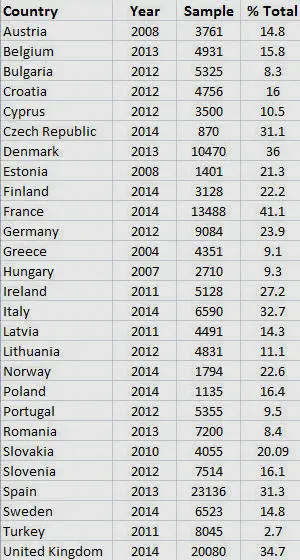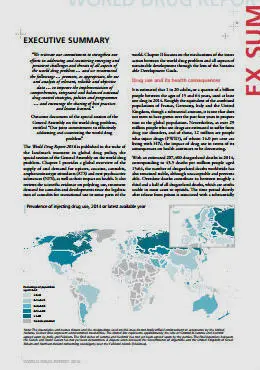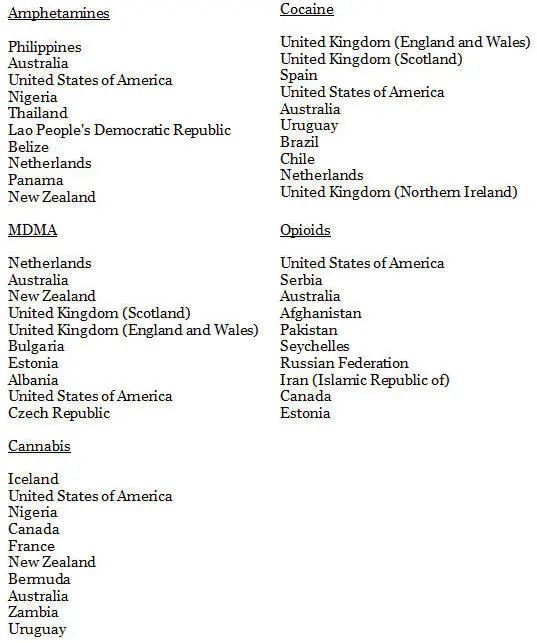How Many People Use Drugs? #
In the UK, the Home Office, in its 2015 Crime Survey for England & Wales, stated that 8.6% of adults aged 16 to 59 “had taken an illicit drug in the last year”. This was similar to previous years, and equates to about 2.9 million people. Illicit presumably means illegal.
It also stated that “3.2% of adults aged 16 to 59 had taken a Class A drug in the last year, equivalent to just over one million people”. It added “2.2% of adults aged 16 to 59 were classed as frequent drug users (having taken any illicit drug more than once a month on average in the last year).”
One of the most comprehensive international studies I found was undertaken on behalf of the National Institute of Drug Abuse, in the US. This surveyed 44,892 students from 382 public and private schools.
When asked which drugs they had used in the previous 12 months, the 17-18 year olds (12th Graders) within this number responded as follows:

As there are estimated to be about 4 million 12th Graders, this would equate to about 1.4 million marijuana users, 200,000 users of hallucinogens, and so forth. A crude extrapolation of this percentage to the entire US population provides a figure of over 100 million marijuana users.
If that sounds like an astonishing figure, it does go some way to explain why, at time of writing, approximately 750,000 people are arrested every year for marijuana offences (source: FBI). Overall, in the US almost half a million people are incarcerated for drug offences (source: The Sentencing Project, 2014), and on average someone is arrested for drug possession every 25 seconds.
Whilst they provide insight, statistics like these barely scratch the surface, particularly as most studies tend not to include the use of legal psychoactives and emerging research chemicals.
THE EMCDDA #
The European Monitoring Centre for Drugs and Drug Addiction (EMCDDA) was inaugurated as an EU agency in 1995. It exists to provide the EU and its member states with a factual overview of European drug problems and a solid evidence base to support the drugs debate.
The following data was published by the EMCDDA in 2016. It details the percentage of adults (15-64) from the stated samples who have used illegal drugs. Note that, with respect to the United Kingdom, this does not include those drugs made illegal subsequent to the passing of the Psychoactive Substances Act 2016.

Source: www.emcdda.europa.eu/data/stats2016#displayTable:GPS-113
From this, for example, it can be deduced via extrapolation that, if identified by their government, more than one third of the UK‘s entire population could be criminalized for their use of drugs. Numerically, this is in excess of 22 million people.
THE UNITED NATIONS #
The United Nations Office on Drugs and Crime (UNODC) presented the following picture of global drug use in its World Drug Report 2016:
“It is estimated that 1 in 20 adults, or a quarter of a billion people between the ages of 15 and 64 years, used at least one drug in 2014. Roughly the equivalent of the combined populations of France, Germany, Italy and the United Kingdom.”
A later reference within the same report was even more precise:
“247 million people used drugs in the past year”.
In terms of specific psychoactives, it cited cannabis and amphetamines as the two most popular drugs, with an estimated 183 million and 33 million global users respectively.



Finally, it stated that the number of drug users was stable, and “does not seem to have grown over the past four years in proportion to the global population”.
SUMMARY #
In summary, there is no doubt that a significant minority of the world’s population choose to use some form of unsanctioned psychoactive substance. This is despite the unremitting propaganda and brutal punitive onslaught of the war on drugs.
Equally, the vast majority of those 247 million people are, in practical terms, denied the basic safety information and education which would, in many cases, help to save lives and alleviate risk. They are unaware of precisely the sort of directly relevant material which is published in this book.
A CURIOSITY: THE POPULARITY OF DRUGS RANKED BY NATION #
In 2014 the UNODC published an interactive map which presented the estimated relative popularity of certain drugs in each country (percentage use by its respective adult population). This is clearly quite an old study now, and some of the data was even older than this, but it does provide an interesting picture/snapshot.
The top 10 territories in terms of percentage use of each of the named drugs were:

The complete dataset from which this was derived can be viewed on the UNODC website, here: